Biology, Ecology, and Management of Prevalent Thrips Species (Thysanoptera: Thripidae) Impacting Blueberry Production in the Southeastern United States
Simple Summary
Abstract
1. Introduction
2. Thrips in Blueberries
3. Biology of Thrips
4. Host Range of Thrips
5. Thrips Species Associated with Blueberry Flowers
5.1. Frankliniella tritici
5.2. Frankliniella bispinosa
5.3. Impacts of F. tritici and F. bispinosa on Blueberry
6. Thrips Species Associated with Blueberry Foliage
6.1. Scirtothrips dorsalis
6.2. Impacts of S. dorsalis on Blueberry
7. Management of Thrips in Blueberries
7.1. Monitoring
7.2. Economic Thresholds
7.3. Cultural Control
7.4. Biological Control
7.5. Chemical Control
8. Conclusions
9. Future Directions
Author Contributions
Funding
Data Availability Statement
Acknowledgments
Conflicts of Interest
References
- Song, G.Q.; Hancock, J. Vaccinium. In Wild Crop Relatives: Genomic and Breeding Resources, Temperate Fruits; Kole, C., Ed.; Springer: Heidelberg, Germany, 2011; pp. 197–221. ISBN 978-3-642-16056-1. [Google Scholar]
- Martău, G.A.; Bernadette-Emőke, T.; Odocheanu, R.; Soporan, D.A.; Bochiș, M.; Simon, E.; Vodnar, D.C. Vaccinium Species (Ericaceae): Phytochemistry and Biological Properties of Medicinal Plants. Molecules 2023, 28, 1533. [Google Scholar] [CrossRef]
- Krishna, P.; Pandey, G.; Thomas, R.; Parks, S. Improving Blueberry Fruit Nutritional Quality through Physiological and Genetic Interventions: A Review of Current Research and Future Directions. Antioxidants 2023, 12, 810. [Google Scholar] [CrossRef] [PubMed]
- Protzman, E. Blueberries Around the Globe—Past, Present, and Future; USDA Foreign Agricultural Service: Washington, DC, USA, 2024. Available online: https://fas.usda.gov/data/blueberries-around-globe-past-present-and-future (accessed on 16 December 2024).
- USDA National Agricultural Statistics Service. New Jersey Blueberry Statistics 2023. 2023. Available online: https://www.nass.usda.gov/Statistics_by_State/New_Jersey/Publications/Blueberry_Statistics/NJ-2023-Blueberry.pdf (accessed on 16 December 2024).
- Daniel, J. 2023 Georgia Farm Gate Value Report; University of Georgia Center for Agribusiness and Economic Development: Athens, GA, USA, 2025; pp. 55–56. Available online: https://caed.uga.edu/publications/farm-gate-value.html (accessed on 27 March 2025).
- Arévalo, H.A.; Liburd, O.E. Horizontal and Vertical Distribution of Flower Thrips in Southern Highbush and Rabbiteye Blueberry Plantings, with Notes on a New Sampling Method for Thrips Inside Blueberry Flowers. J. Econ. Entomol. 2007, 100, 1622–1632. [Google Scholar] [CrossRef]
- Turner, J.C.L.; Liburd, O.E. Insect Management in Blueberries in the Eastern United States: ENY-411/IG070. EDIS 2007, 2007, IG070. [Google Scholar] [CrossRef]
- Williamson, J.G.; Harmon, P.F.; Liburd, O.E.; Dittmar, P. 2019 Florida Blueberry Integrated Pest Management Guide; University of Florida IFAS Extension: Gainesville, FL, USA, 2019; p. 38. [Google Scholar]
- Reynaud, P. Thrips (Thysanoptera). Chapter 13.1. BioRisk 2010, 4, 767–791. [Google Scholar] [CrossRef]
- Kirk, W.D.J. Distribution, Abundance and Population Dynamics. In Thrips as Crop Pests; Lewis, T., Ed.; CAB International: Wallingford, UK, 1997; pp. 217–257. [Google Scholar]
- Polavarapu, S.; Polk, D. The Blueberry Bulletin; Rutgers New Jersey Agricultural Experiment Station: New Brunswick, NJ, USA, 2001; Available online: https://njaes.rutgers.edu/blueberry-bulletin/pdfs/2001/bb-v17n08.pdf (accessed on 24 December 2024).
- Haviland, D.R.; Rill, S.M.; Morse, J.G. Southern Highbush Blueberries Are a New Host for Scirtothrips citri (Thysanoptera: Thripidae) in California. Fla. Entomol. 2009, 92, 147–149. [Google Scholar] [CrossRef]
- Langille, R.H.; Forsythe, H.Y. Biology of the Blueberry Thrips Frankliniella vaccinii and Catinathrips kainos in Maine (Thysanoptera: Thripidae). Can. Entomol. 1972, 104, 1781–1786. [Google Scholar] [CrossRef]
- Kumar, V.; Kakkar, G.; McKenzie, C.L.; Seal, D.R.; Osborne, L.S.; Kumar, V.; Kakkar, G.; McKenzie, C.L.; Seal, D.R.; Osborne, L.S. An Overview of Chilli Thrips, Scirtothrips dorsalis (Thysanoptera: Thripidae) Biology, Distribution and Management. In Weed and Pest Control—Conventional and New Challenges; Soloneski, S., Larramendy, M.L., Eds.; IntechOpen: London, UK, 2013; ISBN 978-953-51-0984-6. [Google Scholar]
- Arevalo, H.A.; Fraulo, A.B.; Liburd, O.E. Key to the Most Common Species of Thrips Found in Early-Season Blueberry Fields in Florida and Southern Georgia: ENY-836/IN679. EDIS 2006, 2006, IN679. [Google Scholar] [CrossRef]
- Spiers, J.D.; Matta, F.B.; Marshall, D.A.; Sampson, B.J. Effects of Kaolin Clay Application on Flower Bud Development, Fruit Quality and Yield, and Flower Thrips [Frankliniella spp. (Thysanoptera: Thripidae)] Populations of Blueberry Plants. Small Fruits Rev. 2004, 3, 361–373. [Google Scholar] [CrossRef]
- Liburd, O.E.; Panthi, B.R.; Phillips, D.A. Chilli Thrips on Blueberries in Florida. EDIS 2020, 2020, IN1298. [Google Scholar] [CrossRef]
- Liburd, O.E.; Arevalo, H.A. Integrated Strategies for Controlling Flower Thrips in Southern Highbush Blueberries: IPM-140/IN637. EDIS 2019, 2019, IN637. [Google Scholar] [CrossRef]
- Arthurs, S.; Kok-Yokomi, M.L.; Smith, H.A. Florida Flower Thrips—Frankliniella Bispinosa; University of Florida Entomology and Nematology Department: Gainesville, FL, USA, 2024; Available online: https://entnemdept.ufl.edu/Creatures/veg/thrips/Frankliniella_bispinosa.htm (accessed on 27 August 2024).
- Rodriguez-Saona, C.R.; Polavarapu, S.; Barry, J.D.; Polk, D.; Jörnsten, R.; Oudemans, P.V.; Liburd, O.E. Color Preference, Seasonality, Spatial Distribution and Species Composition of Thrips (Thysanoptera: Thripidae) in Northern Highbush Blueberries. Crop Prot. 2010, 29, 1331–1340. [Google Scholar] [CrossRef]
- England, G.K.; Rhodes, E.M.; Liburd, O.E. Thrips Monitoring in Blueberries. Proc. Fla. State Hort. Soc. 2008, 121, 28–29. [Google Scholar]
- Mound, L.A.; Kibby, G. Thysanoptera: An Identification Guide, 2nd ed.; CABI: Wallingford, UK, 1998; Available online: https://www.cabidigitallibrary.org/doi/abs/10.1079/9780851992112.0000 (accessed on 24 March 2025).
- Mehle, N.; Trdan, S. Traditional and Modern Methods for the Identification of Thrips (Thysanoptera) Species. J. Pest. Sci. 2012, 85, 179–190. [Google Scholar] [CrossRef]
- Lewis, T. Thrips: Their Biology, Ecology and Economic Importance; Academic Press: London, UK, 1973. [Google Scholar]
- Hameed, A.; Ulmer, J.M.; Miko, I.; Rosa, C.; Rajotte, E.G. Morphology of the Female Reproductive System of the Soybean Thrips, Neohydatothrips variabilis (Beach, 1896) (Thysanoptera: Thripidae). Insects 2022, 13, 566. [Google Scholar] [CrossRef]
- Lowry, V.K.; Smith, J.W., Jr.; Mitchell, F.L. Life-Fertility Tables for Frankliniella fusca (Hinds) and F. occidentals (Pergande) (Thysanoptera: Thripidae) on Peanut. Ann. Entomol. Soc. Am. 1992, 85, 744–754. [Google Scholar] [CrossRef]
- Quaintance, A.L. The Strawberry Thrips and the Onion Thrips; University of Florida Agricultural Experiment Stations: Gainesville, FL, USA, 1898. [Google Scholar]
- Watts, J.G. Chirothripoides dendropogonus, a New Species of Thrips of a Family New to North America (Chirothripoididae: Thysanoptera)1. Ann. Entomol. Soc. Am. 1934, 27, 542–544. [Google Scholar] [CrossRef]
- Watts, J.G. A Study of the Biology of the Flower Thrips Frankliniella tritici (Fitch) with Special Reference to Cotton. Bull. S. C. Agric. Exp. Stn. 1936, 306, 5–45. [Google Scholar]
- Lublinkhof, J.; Foster, D. Development and Reproductive Capacity of Frankliniella occidentalis (Thysanoptera: Thripidae) Reared at Three Temperatures. [Unpublished Manuscript]. Available online: https://galileo-uga.primo.exlibrisgroup.com (accessed on 27 March 2025).
- Garrick, T.A.; Liburd, O.E.; Funderburk, J. Effect of Humidity on Fecundity and Egg Incubation of Frankliniella bispinosa and Frankliniella occidentalis (Thysanoptera: Thripidae). Fla. Entomol. 2016, 99, 505–508. [Google Scholar] [CrossRef]
- Reitz, S.R. Comparative Bionomics of Frankliniella occidentalis and Frankliniella tritici. Fla. Entomol. 2008, 91, 474–476. [Google Scholar] [CrossRef]
- Paini, D.R.; Funderburk, J.E.; Reitz, S.R. Competitive Exclusion of a Worldwide Invasive Pest by a Native. Quantifying Competition between Two Phytophagous Insects on Two Host Plant Species. J. Anim. Ecol. 2008, 77, 184–190. [Google Scholar] [CrossRef]
- Reitz, S.R. Seasonal and within plant distribution of Frankliniella thrips (Thysanoptera: Thripidae) in North Florida tomatoes. Fla. Entomol. 2002, 85, 431–439. [Google Scholar] [CrossRef]
- Bi-song, Y. Growth, Reproduction and Field Population Dynamics of Frankliniella bispinosa (Thysanoptera: Thripidae). Insect Sci. 2001, 8, 265–270. [Google Scholar] [CrossRef]
- Ramachandran, S.; Funderburk, J.; Stavisky, J.; Olson, S. Population Abundance and Movement of Frankliniella Species and Orius insidiosus in Field Pepper. Agric. For. Entomol. 2001, 3, 129–137. [Google Scholar] [CrossRef]
- Kang, S.H.; Lee, J.-H.; Kim, D.-S. Temperature-Dependent Fecundity of Overwintered Scirtothrips dorsalis (Thysanoptera: Thripidae) and Its Oviposition Model with Field Validation. Pest. Manag. Sci. 2015, 71, 1441–1451. [Google Scholar] [CrossRef]
- Monterrosa, A.; Joseph, S.V.; Hudson, W. Chilli thrips: Biology and management in the nursery. Univ. GA Coop. Ext. Circ. 2020, 1210, 1–2. [Google Scholar]
- Ananthakrishnan, T.N. Bionomics of Thrips. Annu. Rev. Entomol. 1993, 38, 71–92. [Google Scholar] [CrossRef]
- Glick, P.A. The Distribution of Insects, Spiders, and Mites in the Air. USA Dep. Agric. Technol. Bull. 1939, 673, 1–150. [Google Scholar]
- Lewis, T. Flight and dispersal. In Thrips as Crop Pests; Lewis, T., Ed.; CAB International: Wallingford, UK, 1997; pp. 175–196. [Google Scholar]
- Chellemi, D.O.; Funderburk, J.E.; Hall, D.W. Seasonal Abundance of Flower-Inhabiting Frankliniella Species (Thysanoptera: Thripidae) on Wild Plant Species. Environ. Entomol. 1994, 23, 337–342. [Google Scholar] [CrossRef]
- Toapanta, M.; Funderburk, J.; Webb, S.; Chellemi, D.; Tsai, J. Abundance of Frankliniella spp. (Thysanoptera: Thripidae) on Winter and Spring Host Plants. Environ. Entomol. 1996, 25, 793–800. [Google Scholar] [CrossRef]
- Chamberlin, J.R.; Todd, J.W.; Beshear, R.J.; Culbreath, A.K.; Demski, J.W. Overwintering Hosts and Wingform of Thrips, Frankliniella spp., in Georgia (Thysanoptera: Thripidae): Implications for Management of Spotted Wilt Disease. Environ. Entomol. 1992, 21, 121–128. [Google Scholar] [CrossRef]
- Webb, R.E.; Jacklin, S.W.; Johnson, G.V.; Mackley, J.W.; Paugh, E.J. Seasonal Variation in Populations of Flower Thrips in Georgia, Maryland, and New York13. J. Econ. Entomol. 1970, 63, 1392–1394. [Google Scholar] [CrossRef]
- Irwin, M.E.; Yeargan, K.V.; Marston, N.L. Spatial and Seasonal Patterns of Phytophagous Thrips 1 in Soybean Fields with Comments on Sampling Techniques 2. Environ. Entomol. 1979, 8, 131–140. [Google Scholar] [CrossRef]
- Mound, L.A.; Palmer, J.M. Identification, Distribution and Host-Plants of the Pest Species of Scirtothrips (Thysanoptera: Thripidae). Bull. Entomol. Res. 1981, 71, 467–479. [Google Scholar] [CrossRef]
- Klassen, W.; Seal, D.R.; Ciomperlik, M.A.; Fieselmann, D.A. The chilli thrips, Scirtothrips dorsalis: Current status in the Greater Caribbean Region. In Proceedings of the 44th Annual Meeting of the Caribbean Food Crops Society, Miami, FL, USA, 13–17 July 2008; Caribbean Food Crops Society: Miami, FL, USA, 2008; pp. 100–105. [Google Scholar]
- Seal, D.R.; Klassen, W.; Kumar, V. Biological Parameters of Scirtothrips dorsalis (Thysanoptera: Thripidae) on Selected Hosts. Environ. Entomol. 2010, 39, 1389–1398. [Google Scholar] [CrossRef]
- Cluever, J.D.; Smith, H.A. Pest information guide: Eastern flower thrips Frankliniella tritici (Fitch): ENY-894/IN1137. EDIS 2016, 2016, IN1137. [Google Scholar] [CrossRef]
- Riley, D.G.; Joseph, S.V.; Srinivasan, R.; Diffie, S. Thrips Vectors of Tospoviruses. J. Integr. Pest Manag. 2011, 2, I1–I10. [Google Scholar] [CrossRef]
- Sprague, D.; Funderburk, J.E.; Lucky, A. Flower thrips, Frankliniella tritici (Fitch) (Insecta: Thysanoptera: Thripidae). EDIS 2019, 2019, IN1236. [Google Scholar] [CrossRef]
- Watson, J.R. The Proper Name and Distribution of the Florida Flower Thrips. Fla. Entomol. 1923, 7, 9–11. [Google Scholar] [CrossRef]
- Frantz, G.; Parks, F.; Mellinger, H.C. Thrips Population Trends in Peppers in Southwest Florida. In Thrips Biology and Management; Parker, B.L., Skinner, M., Lewis, T., Eds.; Springer: Boston, MA, USA, 1995; pp. 111–114. ISBN 978-1-4899-1409-5. [Google Scholar]
- Childers, C.C.; Beshear, R.J.; Brushwein, J.R.; Denmark, H.A. Thrips (Thysanoptera) Species, Their Occurrence and Seasonal Abundance on Developing Buds and Flowers of Florida Citrus. J. Entomol. Sci. 1990, 25, 601–614. [Google Scholar] [CrossRef]
- Sial, A. Monitoring and Management of Flower Thrips in Blueberries|UGA Blueberry Blog. 2021. Available online: https://site.caes.uga.edu/blueberry/2021/02/monitoring-and-management-of-flower-thrips-in-blueberries/ (accessed on 27 March 2025).
- Rhodes, E.M.; Liburd, O.E.; England, G.K. Effects of Southern Highbush Blueberry Cultivar and Treatment Threshold on Flower Thrips Populations. J. Econ. Entomol. 2012, 105, 480–489. [Google Scholar] [CrossRef] [PubMed]
- Kumar, V.; Xiao, Y.; Borden, M.A.; Ahmed, M.Z.; McKenzie, C.L.; Osborne, L.S. Distribution of Scirtothrips dorsalis (Thysanoptera: Thripidae) Cryptic Species Complex in the United States and Reproductive Host Assessment of Its Dominant Member. J. Econ. Entomol. 2023, 116, 1715–1726. [Google Scholar] [CrossRef]
- Kumar, V.; Seal, D.R.; Kakkar, G. Chilli Thrips-Scirtothrips dorsalis Hood; University of Florida Entomology and Nematology Department: Gainesville, FL, USA, 2024; Available online: https://entnemdept.ufl.edu/creatures/orn/thrips/chilli_thrips.htm (accessed on 6 September 2024).
- Nietschke, B.S.; Borchert, D.M.; Magarey, R.D.; Ciomperlik, M.A. Climatological Potential for Scirtothrips dorsalis (Thysanoptera: Thripidae) Establishment in the United States. Fla. Entomol. 2008, 91, 79–86. [Google Scholar] [CrossRef]
- Panthi, B.R.; Renkema, J.M.; Lahiri, S.; Liburd, O.E. Spatio-Temporal Distribution and Fixed-Precision Sampling Plan of Scirtothrips dorsalis (Thysanoptera: Thripidae) in Florida Blueberry. Insects 2021, 12, 256. [Google Scholar] [CrossRef]
- Hollingsworth, R.G.; Sewake, K.T.; Armstrong, J.W. Scouting Methods for Detection of Thrips (Thysanoptera: Thripidae) on Dendrobium Orchids in Hawaii. Environ. Entomol. 2002, 31, 523–532. [Google Scholar] [CrossRef]
- Liburd, O.E.; Sarzynski, E.M.; Arėvalo, H.A.; MacKenzie, K. Monitoring and emergence of flower thrips species in rabbiteye and southern highbush blueberries. Acta. Hortic. 2009, 810, 251–258. [Google Scholar] [CrossRef]
- Aliakbarpour, H.; Rawi, C.S.M. Evaluation of Yellow Sticky Traps for Monitoring the Population of Thrips (Thysanoptera) in a Mango Orchard. Environ. Entomol. 2011, 40, 873–879. [Google Scholar] [CrossRef]
- Joost, P.H.; Riley, D.G. Sampling Techniques for Thrips (Thysanoptera: Thripidae) in Preflowering Tomato. J. Econ. Entomol. 2004, 97, 1450–1454. [Google Scholar] [CrossRef] [PubMed]
- Herms, D.A. Using Degree-Days and Plant Phenology to Predict Pest Activity. In IPM of Midwest Landscapes; Krischik, V., Davidson, J., Eds.; University of Illinois: Urbana-Champaign, IL, USA, 2004; pp. 49–59. [Google Scholar]
- Higley, L.G.; Pedigo, L.P. (Eds.) Economic Thresholds for Integrated Pest Management; University of Nebraska Press: Lincoln, NE, USA, 1996; p. 327. [Google Scholar]
- Funderburk, J. Management of the Western Flower Thrips (Thysanoptera: Thripidae) in Fruiting Vegetables. Fla. Entomol. 2009, 92, 1–6. [Google Scholar] [CrossRef]
- Northfield, T.D.; Paini, D.R.; Funderburk, J.E.; Reitz, S.R. Annual Cycles of Frankliniella spp. (Thysanoptera: Thripidae) Thrips Abundance on North Florida Uncultivated Reproductive Hosts: Predicting Possible Sources of Pest Outbreaks. Ann. Entomol. Soc. Am. 2008, 101, 769–778. [Google Scholar] [CrossRef]
- Reitz, S.R.; Yearby, E.L.; Funderburk, J.E.; Stavisky, J.; Momol, M.T.; Olson, S.M. Integrated Management Tactics for Frankliniella Thrips (Thysanoptera: Thripidae) in Field-Grown Pepper. J. Econ. Entomol. 2003, 96, 1201–1214. [Google Scholar] [CrossRef] [PubMed]
- Kigathi, R.; Poehling, H.-M. UV-Absorbing Films and Nets Affect the Dispersal of Western Flower Thrips, Frankliniella occidentalis (Thysanoptera: Thripidae). J. Appl. Entomol. 2012, 136, 761–771. [Google Scholar] [CrossRef]
- Gurr, G.M.; Wratten, S.D.; Barbosa, P. Success in Conservation Biological Control of Arthropods. In Biological Control: Measures of Success; Gurr, G., Wratten, S., Eds.; Springer: Dordrecht, The Netherlands, 2000; pp. 105–132. ISBN 978-94-011-4014-0. [Google Scholar]
- Mouden, S.; Sarmiento, K.F.; Klinkhamer, P.G.; Leiss, K.A. Integrated Pest Management in Western Flower Thrips: Past, Present and Future. Pest Manag. Sci. 2017, 73, 813–822. [Google Scholar] [CrossRef] [PubMed]
- Baez, I.; Reitz, S.R.; Funderburk, J.E. Predation by Orius Insidiosus (Heteroptera: Anthocoridae) on Life Stages and Species of Frankliniella Flower Thrips (Thysanoptera: Thripidae) in Pepper Flowers. Environ. Entomol. 2004, 33, 662–670. [Google Scholar] [CrossRef]
- Demirozer, O.; Tyler-Julian, K.; Funderburk, J.; Leppla, N.; Reitz, S. Frankliniella occidentalis (Pergande) Integrated Pest Management Programs for Fruiting Vegetables in Florida. Pest Manag. Sci. 2012, 68, 1537–1545. [Google Scholar] [CrossRef]
- Buitenhuis, R.; Murphy, G.; Shipp, L.; Scott-Dupree, C. Amblyseius swirskii in Greenhouse Production Systems: A Floricultural Perspective. Exp. Appl. Acarol. 2015, 65, 451–464. [Google Scholar] [CrossRef] [PubMed]
- Arévalo, H.A.; Fraulo, A.B.; Liburd, O.E. Management of Flower Thrips in Blueberries in Florida. Fla. Entomol. 2009, 92, 14–17. [Google Scholar] [CrossRef]
- Liburd, O.E.; Arevalo, H.A.; Rhodes, E.M. Efficacy of Reduced-Risk Insecticides to Control Flower Thrips in Early-Season Blueberries and Their Effect on Orius insidiosus, a Natural Enemy of Flower Thrips. Agric. Sci. 2017, 8, 356–370. [Google Scholar] [CrossRef][Green Version]
- Zhang, B.; Qian, W.; Qiao, X.; Xi, Y.; Wan, F. Invasion Biology, Ecology, and Management of Frankliniella occidentalis in China. Arch. Insect. Biochem. Physiol. 2019, 102, e21613. [Google Scholar] [CrossRef]
- Adhikari, R.; Jacobs, J.; Williams, Z.; Sial, A.A. Efficacy of Selected Insecticides against Flower Thrips Infesting Southern Highbush Blueberry, 2023. Arthropod Manag. Tests 2024, 49, tsae085. [Google Scholar] [CrossRef]
- Adhikari, R.; Jacobs, J.; Williams, Z.; Sial, A. Control of Flower Thrips on Rabbiteye Blueberry, 2024. Arthropod Manag. Tests 2024, 49, tsae086. [Google Scholar] [CrossRef]
- Renkema, J.M.; Krey, K.; Devkota, S.; Liburd, O.E.; Funderburk, J. Efficacy of Insecticides for Season-Long Control of Thrips (Thysanoptera: Thripidae) in Winter Strawberries in Florida. Crop Prot. 2020, 127, 104945. [Google Scholar] [CrossRef]
- Cloyd, R.A. Western Flower Thrips (Frankliniella occidentalis) Management on Ornamental Crops Grown in Greenhouses: Have We Reached an Impasse? Pest Technol. 2009, 3, 1–9. [Google Scholar]
- Liburd, O.; Phillips, D. Managing Flower Thrips in Southern Highbush Blueberry in Florida; Florida Blueberry Growers Association: Gainesville, FL, USA, 2024. [Google Scholar]

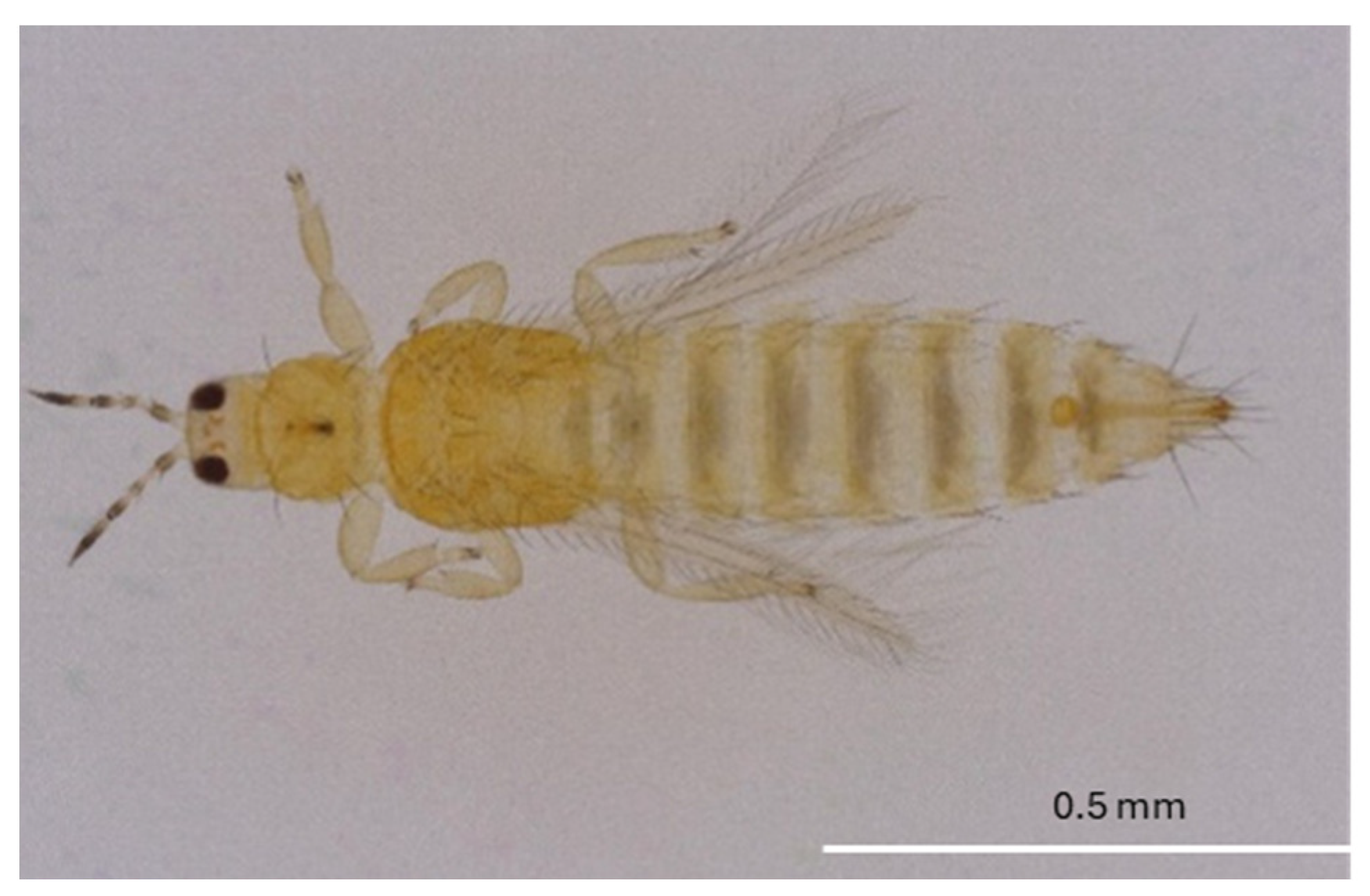
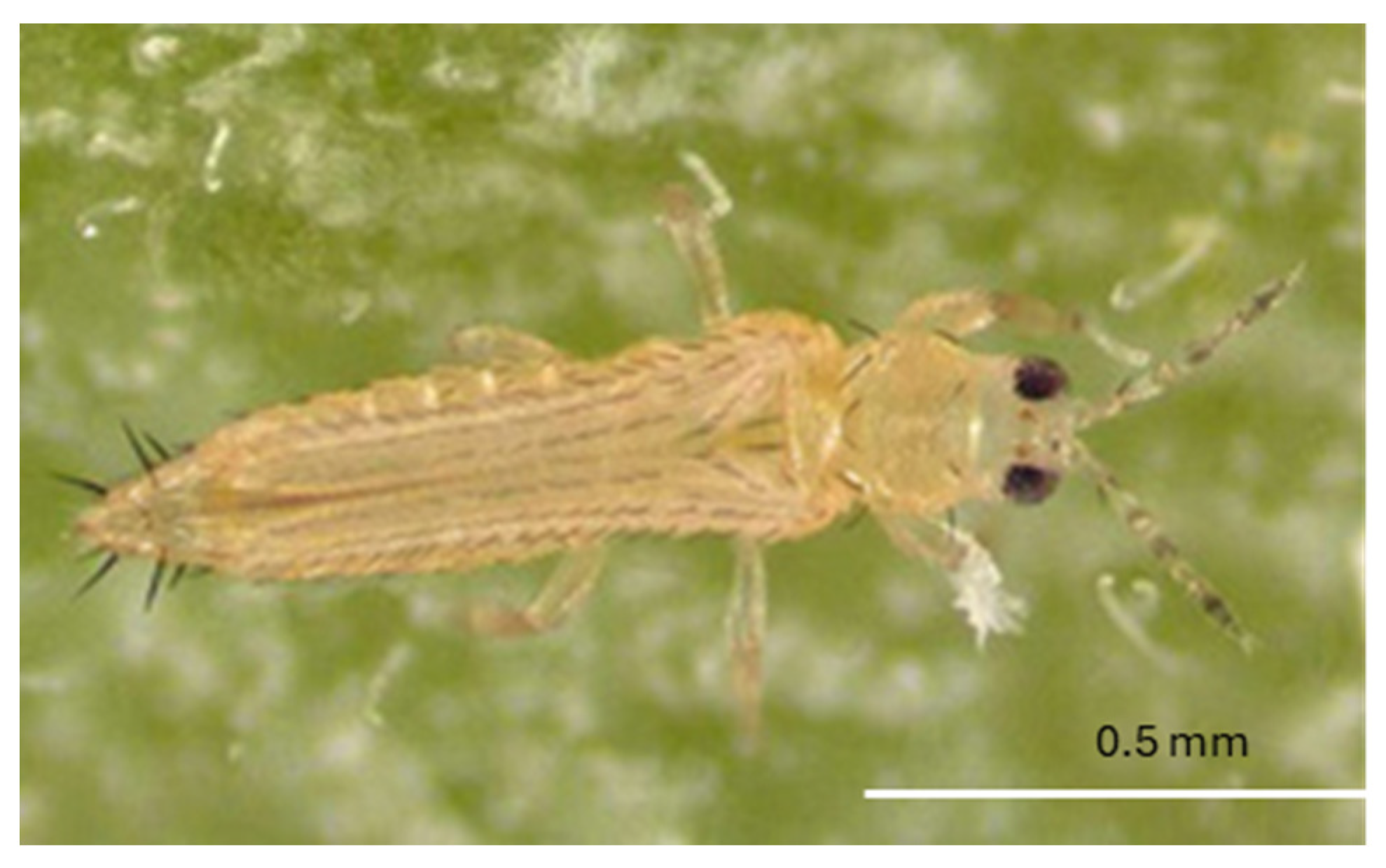
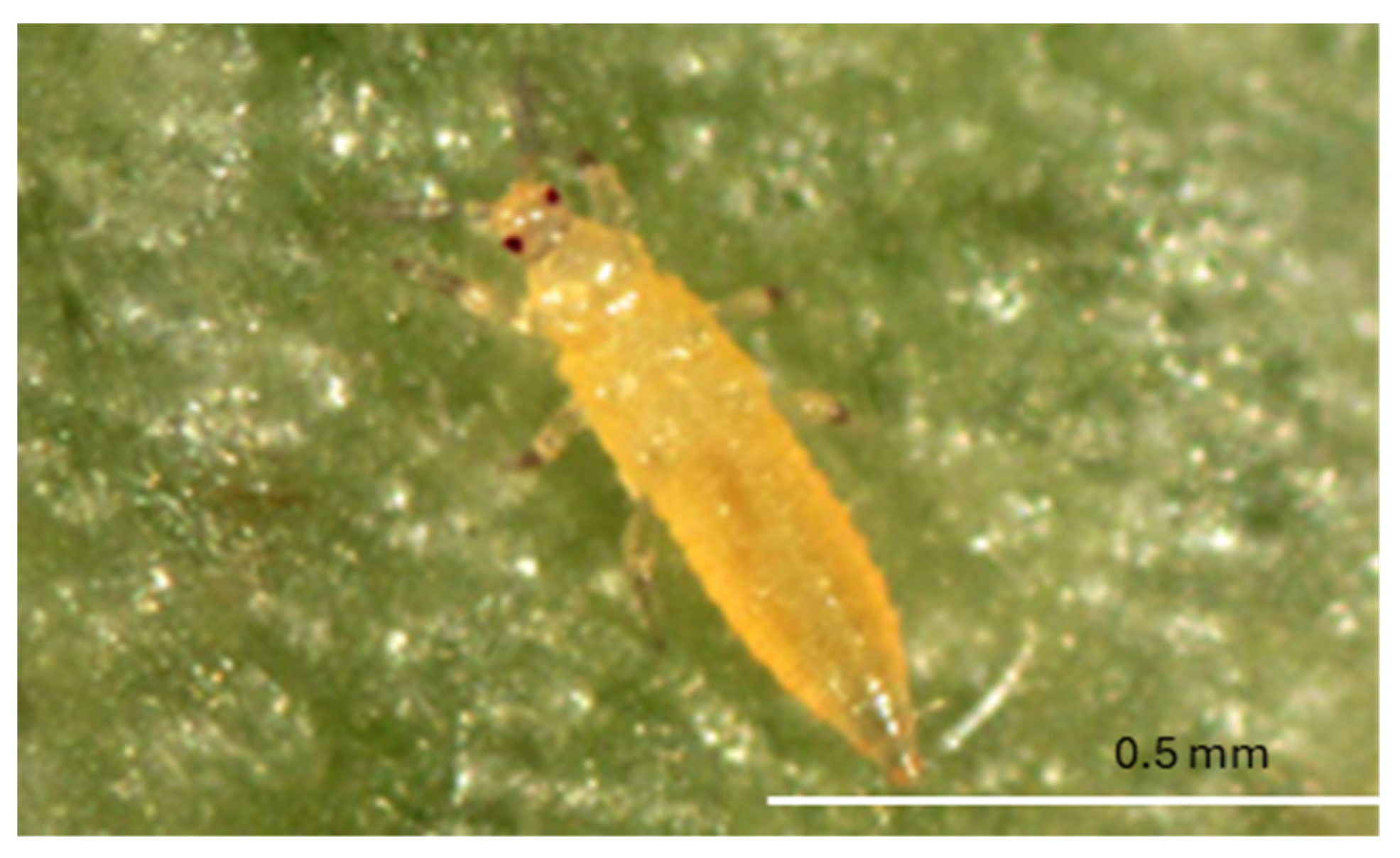
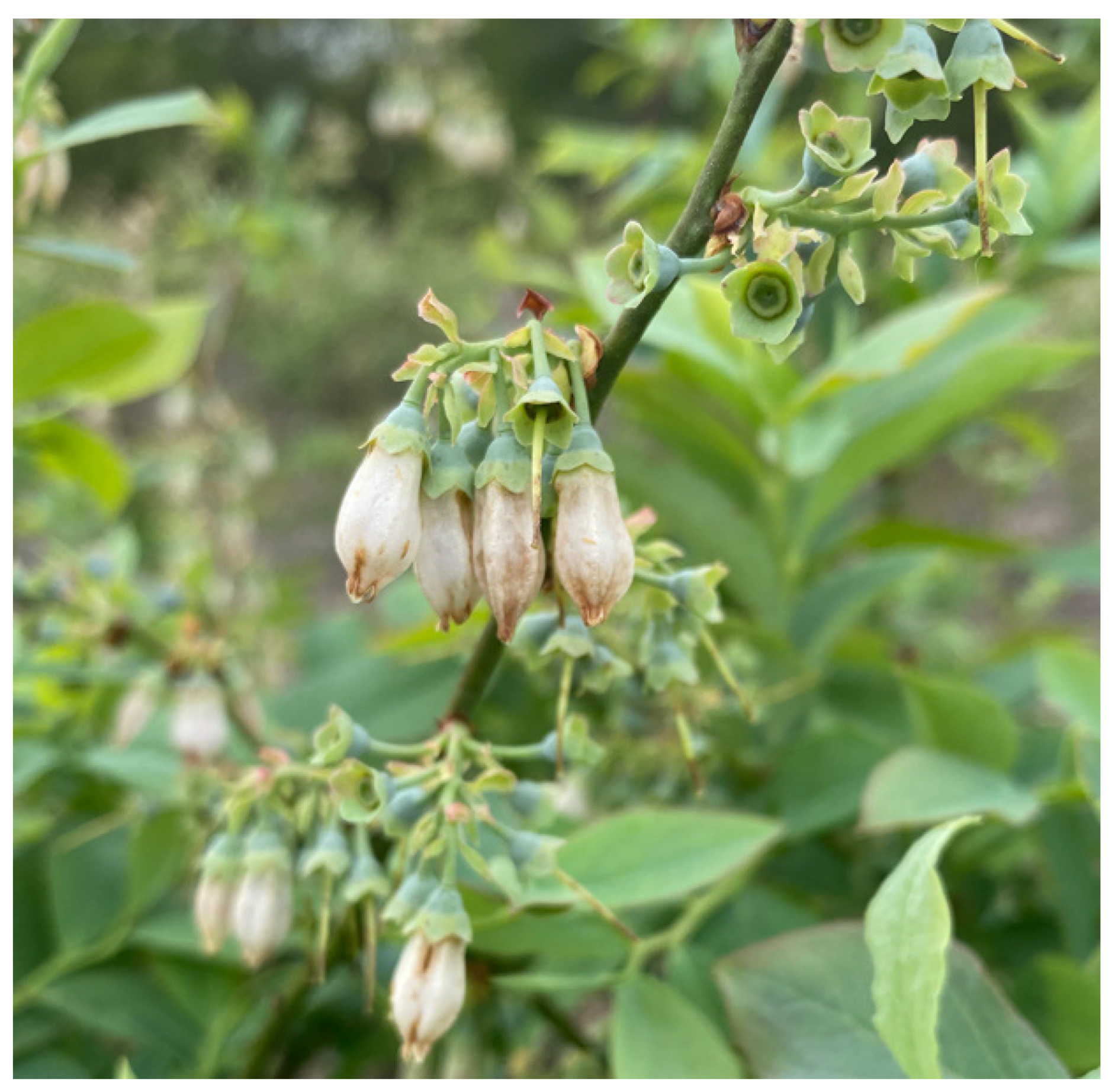

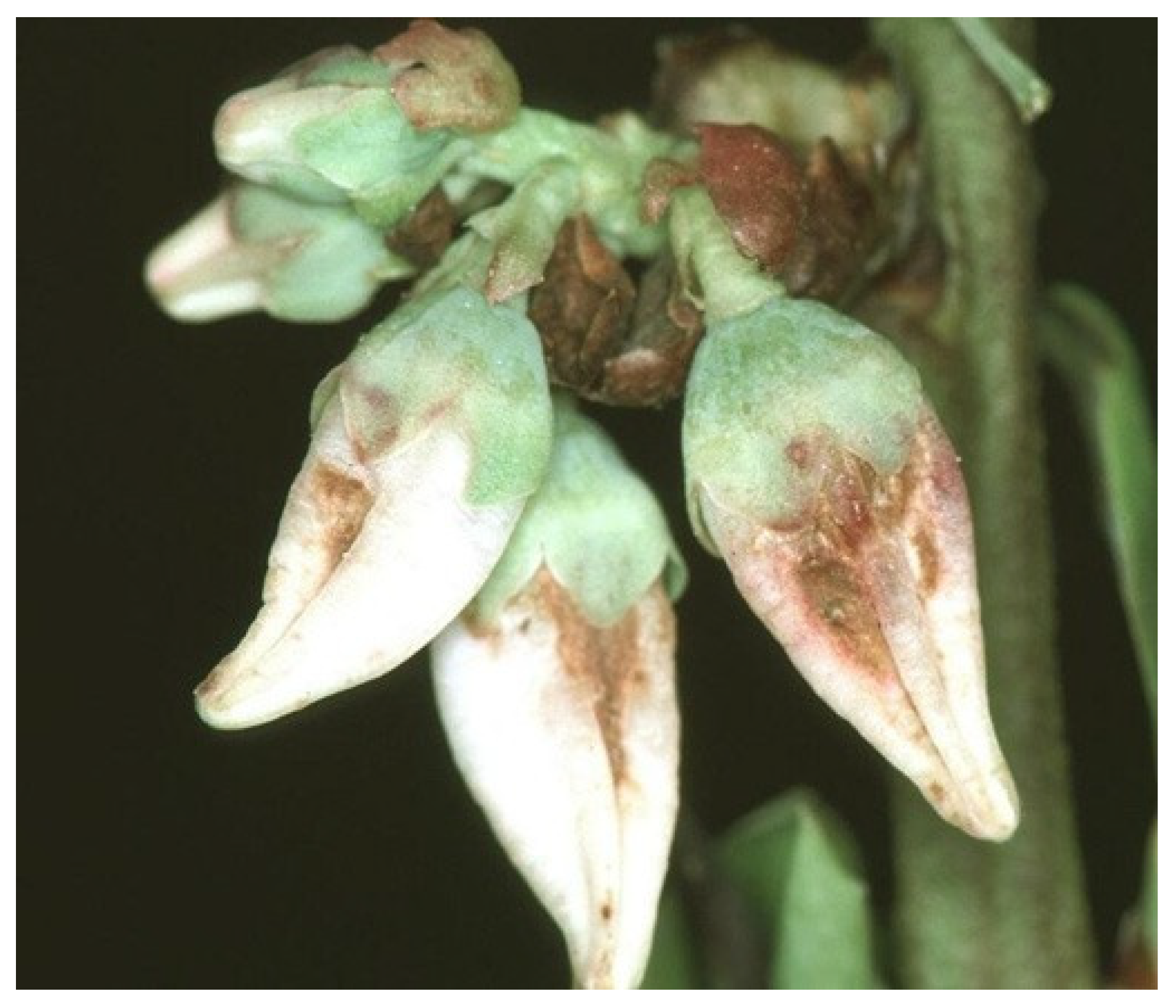
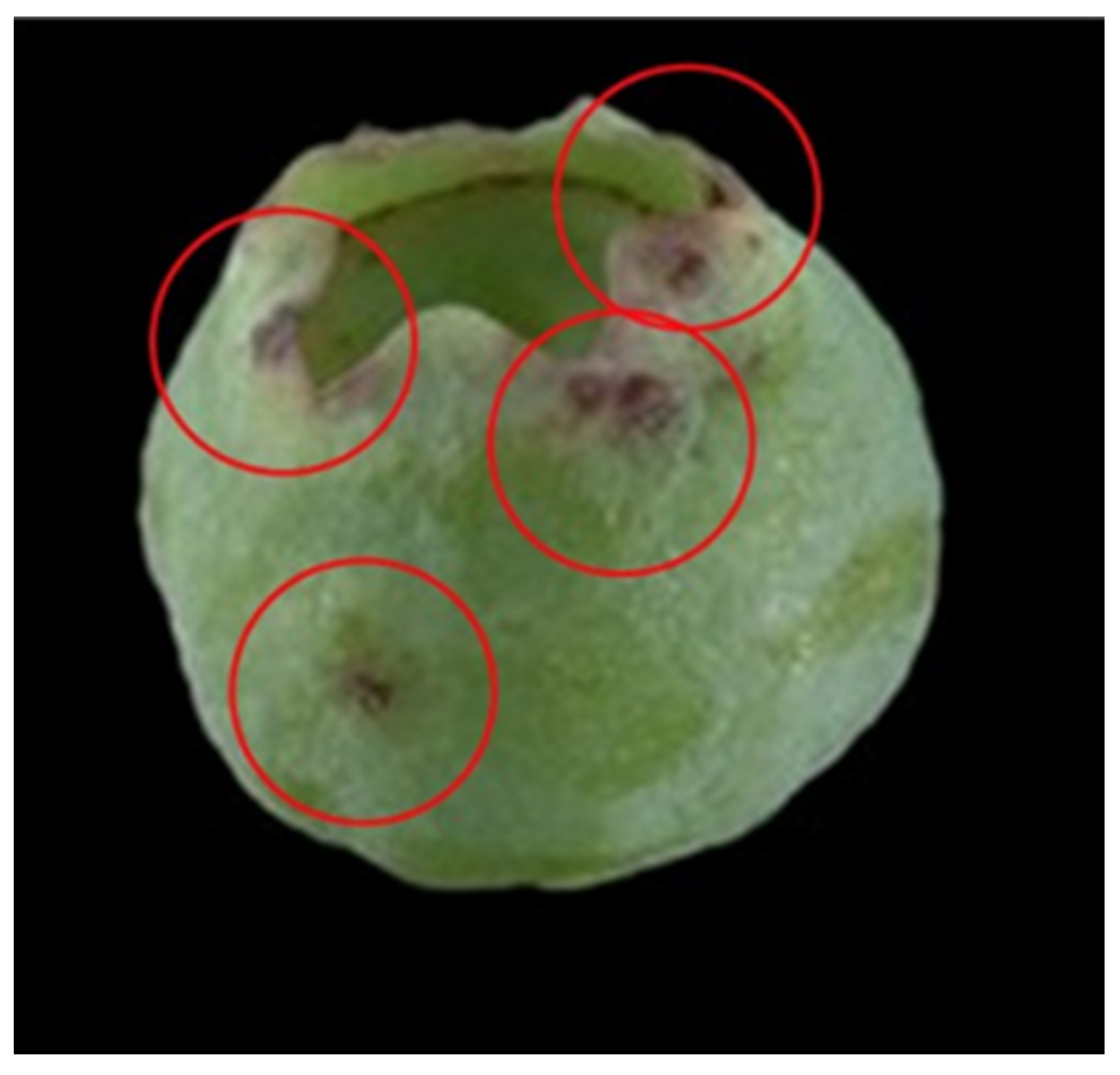
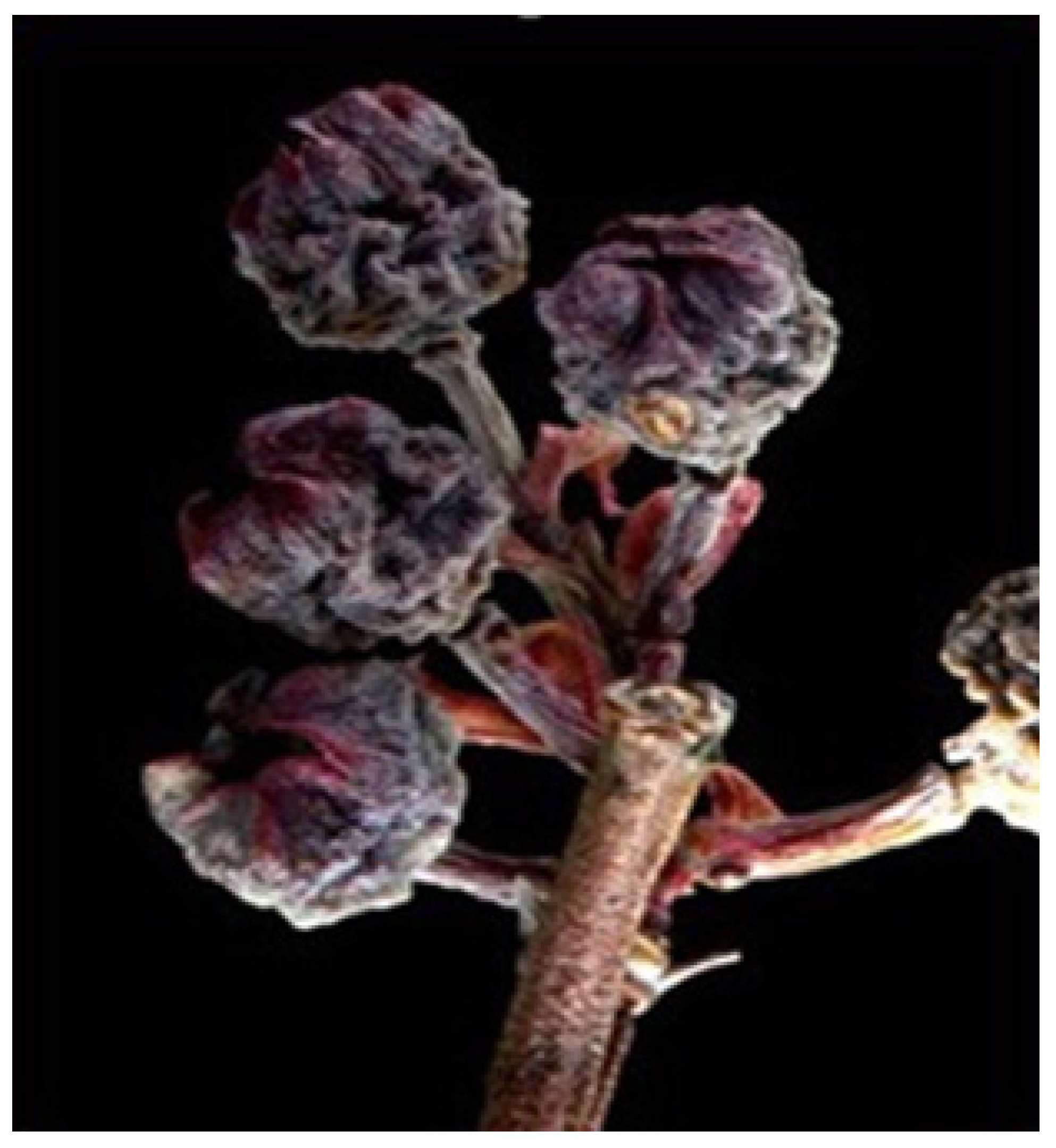
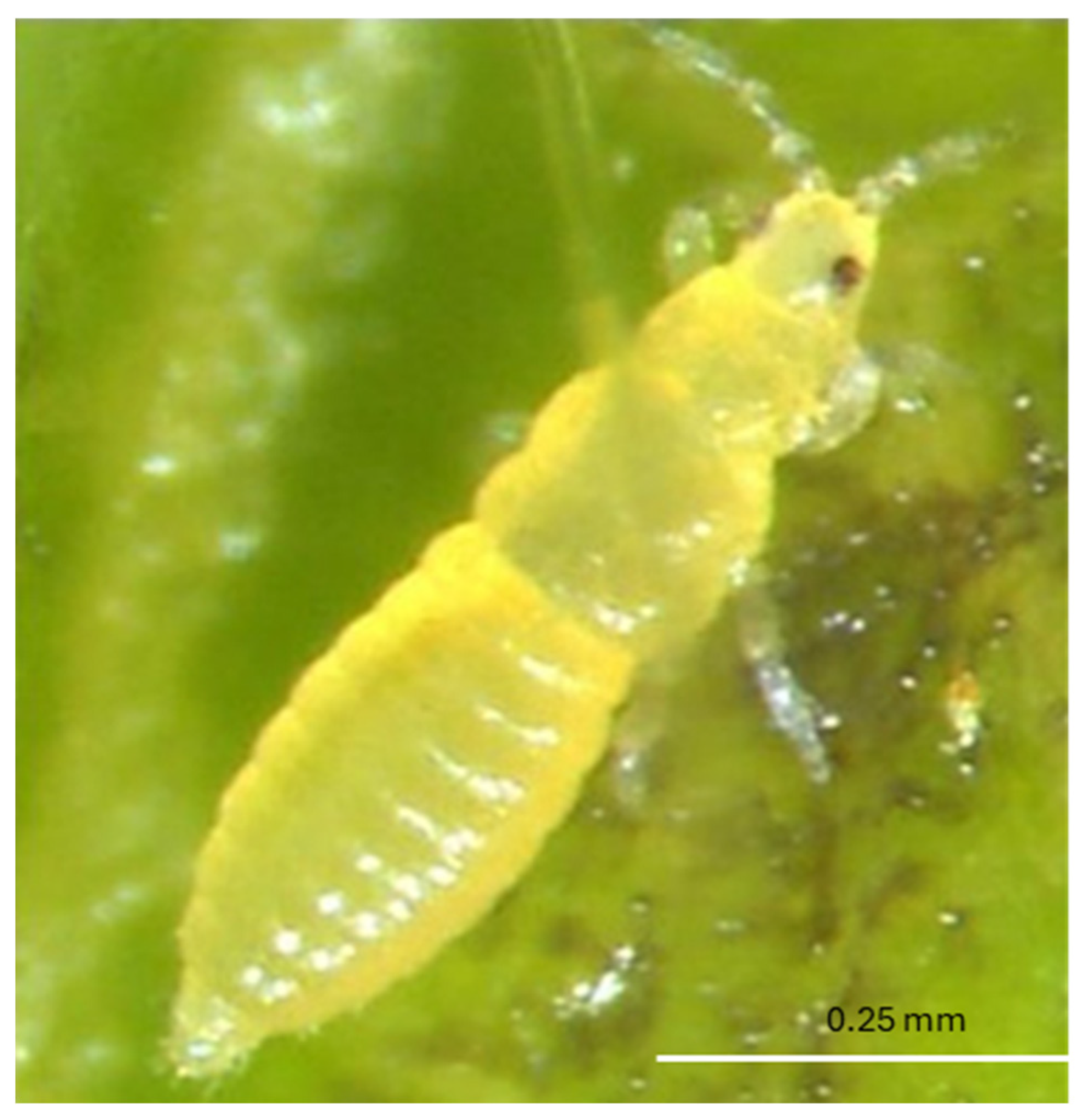
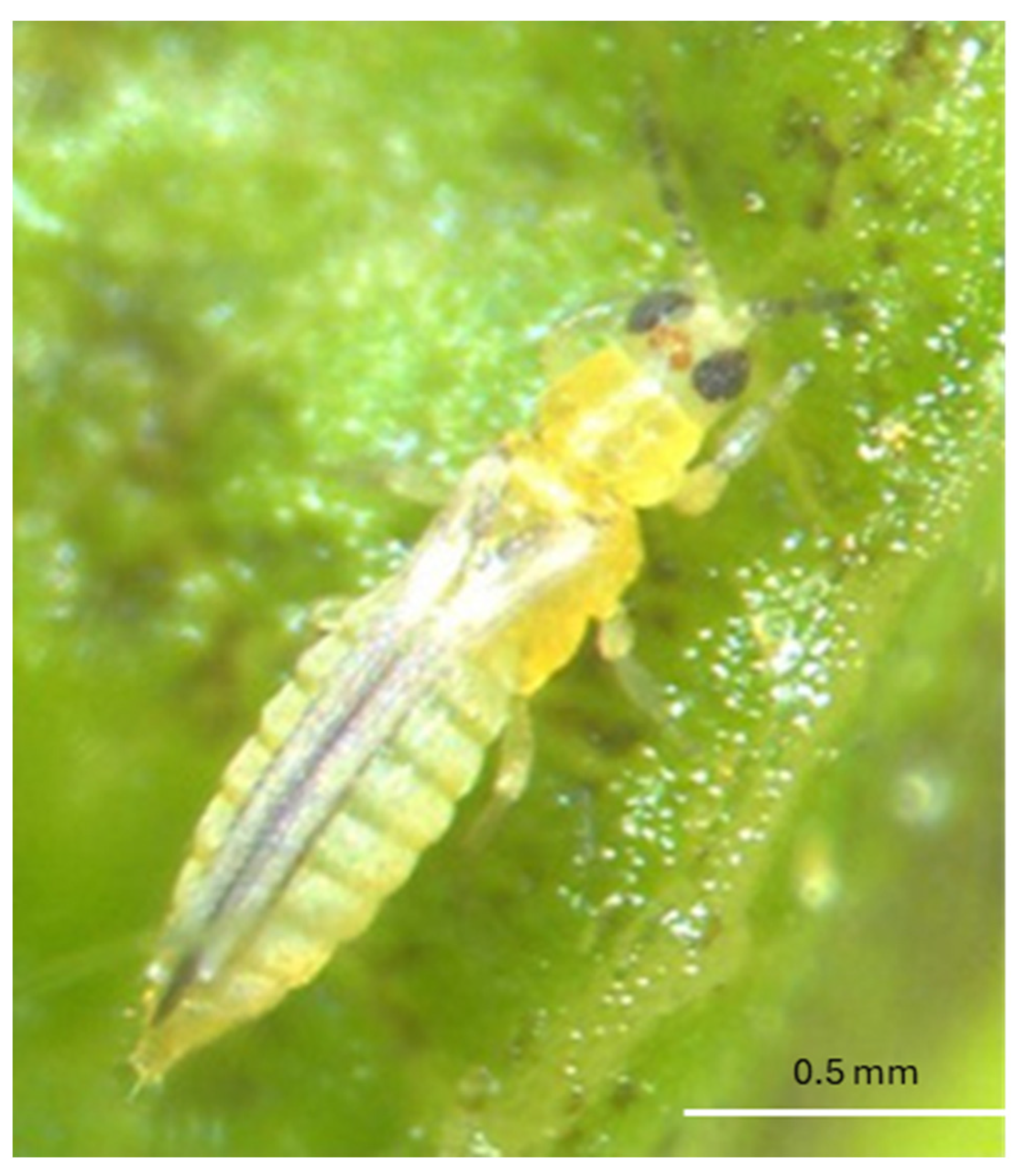

Disclaimer/Publisher’s Note: The statements, opinions and data contained in all publications are solely those of the individual author(s) and contributor(s) and not of MDPI and/or the editor(s). MDPI and/or the editor(s) disclaim responsibility for any injury to people or property resulting from any ideas, methods, instructions or products referred to in the content. |
© 2025 by the authors. Licensee MDPI, Basel, Switzerland. This article is an open access article distributed under the terms and conditions of the Creative Commons Attribution (CC BY) license (https://creativecommons.org/licenses/by/4.0/).
Share and Cite
Adhikari, R.; Riley, D.G.; Srinivasan, R.; Abney, M.; Jones, C.; Sial, A.A. Biology, Ecology, and Management of Prevalent Thrips Species (Thysanoptera: Thripidae) Impacting Blueberry Production in the Southeastern United States. Insects 2025, 16, 653. https://doi.org/10.3390/insects16070653
Adhikari R, Riley DG, Srinivasan R, Abney M, Jones C, Sial AA. Biology, Ecology, and Management of Prevalent Thrips Species (Thysanoptera: Thripidae) Impacting Blueberry Production in the Southeastern United States. Insects. 2025; 16(7):653. https://doi.org/10.3390/insects16070653
Chicago/Turabian StyleAdhikari, Rosan, David G. Riley, Rajagopalbabu Srinivasan, Mark Abney, Cera Jones, and Ashfaq A. Sial. 2025. "Biology, Ecology, and Management of Prevalent Thrips Species (Thysanoptera: Thripidae) Impacting Blueberry Production in the Southeastern United States" Insects 16, no. 7: 653. https://doi.org/10.3390/insects16070653
APA StyleAdhikari, R., Riley, D. G., Srinivasan, R., Abney, M., Jones, C., & Sial, A. A. (2025). Biology, Ecology, and Management of Prevalent Thrips Species (Thysanoptera: Thripidae) Impacting Blueberry Production in the Southeastern United States. Insects, 16(7), 653. https://doi.org/10.3390/insects16070653








